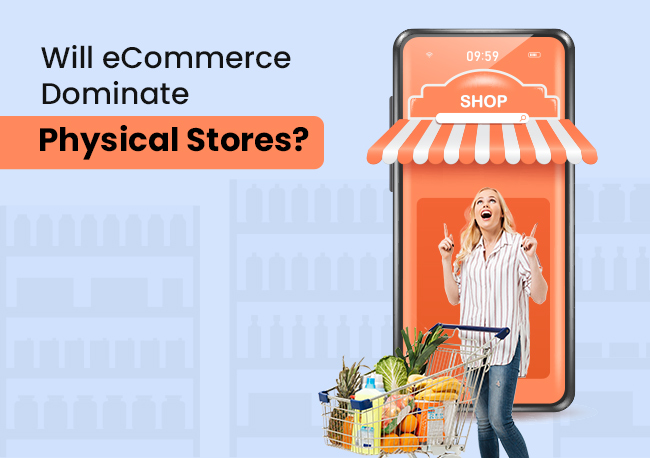| Getting your Trinity Audio player ready... |
eCommerce or Physical Store? You have a choice!
eCommerce has been overhyped in recent years, with some experts predicting it would eventually replace physical stores. You might be surprised that physical store sales increased by 14% in 2022, which is equal to eCommerce. In fact, physical stores hold a 70-75% share of total retail sales of about $7 trillion worldwide in 2022.
Planning to start a retail business?
Want to create a sustainable business model?
This blog is just written for you!
Only India has more than 19 million physical stores and shops, 11 stores for every 1000 people. However, physical stores have not subsided despite the increasing share of online shopping and eCommerce. In fact, we are witnessing post-pandemic people return to traditional shopping.
According to a recent survey, more than 70% of consumers prefer to shop in physical stores on weekends. For many people, shopping is an opportunity to go out of the house and away from computers. eCommerce continues to influence and affect offline businesses like physical stores and small shops. However, with their unique strength, physical stores and eCommerce both are important to drive sales.
Confused! Physical store or eCommerce: which one is suitable for your business? Scroll down to explore the advantages and drawbacks of physical stores and eCommerce before making any final decision.
What is a Physical Store?
Physical stores, also known as brick-and-mortar stores, are conventional retail locations (shops) where customers can visit a physical location to purchase products or services. You can physically inspect products, try them out, and receive immediate assistance from sales executives.
Examples: Shopping malls, street stores, supermarkets, boutiques, local shops, and retail chains like DMart.
Local shops and physical stores (except retail chains) completely depend on the supply chain, where they’re the last link in the chain before products reach consumers. Finished products or goods go from manufacturer to wholesaler, distributor to store, and to consumer.
What is eCommerce?
Electronics commerce refers to the buying and selling of goods and services over the Internet or through digital procurement. It can be done through various online platforms such as websites, mobile applications, social media, and online marketplaces like Amazon, Flipkart, eBay, and Alibaba.
It allows customers to shop from the comfort of their homes using computers or mobile devices where they can view product media, read customer reviews, see features, choose from multiple options, compare prices, and make final purchases by completing transactions electronically.
Compared to traditional stores, the eCommerce business model has fewer steps in the supply chain because big eCommerce companies eliminate wholesalers and stocking steps and directly ship products from manufacturer warehouses to the final consumers. eCommerce has many supply chains and business models, but dropshipping and direct-to-consumer (DTC) are the most popular.
Also Read: A Useful Guide To Building An eCommerce Website From Scratch
Rise of eCommerce in the World
The rise of eCommerce in retail is nothing short of a revolution, reshaping how people buy and sell goods. The world’s retail market has undergone a significant transformation in the past two decades, especially during the 2020 pandemic.
The COVID-19 crisis accelerated the growth trajectory of eCommerce and increased online consumers as lockdown and safety concerns prompted consumers to shift even more toward online shopping.
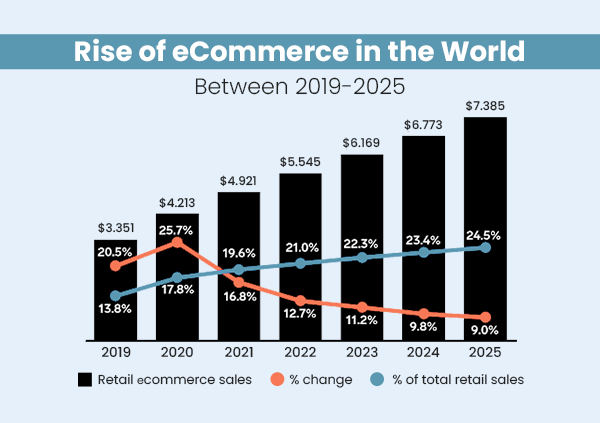
According to recent predictions, the global eCommerce market will reach 6 trillion dollars in 2023. In the coming years, eCommerce will continue growing and see new market trends like hybrid business models.
Experts predicted that the eCommerce market size will exceed 8 trillion dollars by 2026. These figures clearly show a rapidly developing industry with huge potential for digital businesses. So, whether you’re thinking about starting an online store or expanding your eCommerce presence, understanding the possibilities of this ever-growing market is critical.
Businesses can tap into a worldwide market, communicate with customers like never before, and be a part of the exciting adventure of digital commerce by embracing the benefits of eCommerce and utilizing its revolutionary power.
There are many other factors that help eCommerce grow, such as technological advancement, changing consumer behavior, market globalization, logistic advancement, easy digital payments, innovative D2C business models, personalized marketing, and the availability of diverse marketplace platforms.
Still confused about which one is better?
Don’t worry! In the blog “ Will eCommerce Dominate Physical Stores,” we will do an in-depth analysis to solve all your queries.
Also Read: Types Of eCommerce Websites And Models
What are the Benefits of Physical Store?
If you think physical stores are their way out, remember more than 80% of retail sales worldwide and 87% in the USA occur in physical stores, according to a Statista magazine report.
Do you ever wonder what makes a customer shop in a physical store? In-person shopping at local stores gives a unique and enjoyable experience that can’t be possible by online shopping. According to a recent survey, more than 85% of people love shopping in a physical store, at least on holidays and weekends. About 45 percent of consumers prefer to go to a physical store to buy products than online.
Here, we mentioned some factors people select for shopping at local stores:
- According to 28% of consumers, they choose physical stores because they enjoy the shopping experience of a physical location.
- 25% of consumers appreciate seeing, feeling, and trying out goods at local shops.
- 12 % of people prefer offline shopping because they can’t wait for delivery.
- About 10% of people don’t want to pay shipping or delivery charges.
- According to 5-6% of customers, they find more unique products from local retailers than online sellers.
So, suppose you are planning to open a local store or retail chain. In that case, you can attract customers through weekend discounts, holiday offers, gift suggestions, and organizing events for couples, families, and kids.
Factors that Increase the Success Rate of Physical Stores
- Resilience & Adaptability to Changes
- Low Investment Needed
- Offers Personalized Shopping Experience
- Strong Customer Loyalty
- Offers Community Engagement
- Offers Visual Merchandising
- Instant Satisfaction
- Ability to Try Before You Buy
- Gather Valuable in-person Customer Insights
- Easy to Operate and Manage
➔ Resilience & Adaptability to Changes
Physical stores can have remarkable adaptability to changes according to new trends. You can also work on multichannel and integrate online sales while maintaining a robust physical presence.
➔ Low Investment Needed
Small shops and local stores need less investment than an online enterprise. Furniture, rent or lease, and labor costs are more expensive in physical stores. This cost-effectiveness allows you to enter the market with less initial investment.
➔ Offers Personalized Shopping Experience
Physical stores provide a personalized touch to the shopping experiences and in-person interaction with staff so they can understand individual preferences. It helps store owners foster unique and personalized shopping for customers.
➔ Strong Customer Loyalty
When a customer meets you one-on-one multiple times, it creates a strong connection with you and your store, ultimately leading to customer loyalty.
Face-to-face interactions and personalized services are the best ways to create a sense of trust and familiarity, which are important for sustainable customer relationships and long-lasting bonds.
➔ Offers Community Engagement
The local store is a shopping location and serves as a community hub, fostering engagement beyond transactions. People meet their neighbors and greet each other, discuss daily life and local events, and participate in neighborhood activities, strengthening the store’s bond with the community.
➔ Offers Visual Merchandising
Some manufacturers provide banners and visual displays to showcase their products in physical stores to captivate customers. This strategic display and tangible arrangement of products enhance the overall shopping experience. It increases sales and average bill value.
➔ Instant Satisfaction
At physical stores, you can instantly try and taste products, while on online shopping, you need to wait for delivery to check product quality and then find that you can keep it or return it. The easy return process at local shops provides a positive experience and solution for return concerns.
➔ Ability to Try Before You Buy
The tactile nature of physical stores allows consumers to try goods and services before buying them, which is crucial in industries like apparel and electronics. This hands-on experience gives confidence in buying the product.
➔ Gather Valuable in-person Customer Insights
Face-to-face interaction with your customers gives you real-time insights into customers’ preferences and behaviors. It will help you take immediate action and also enhance your informed decision-making.
➔ Easy to Operate and Manage
Operating physical stores often involves less complexity than expansive websites and applications. Small stores are easy to manage and operate with fewer workers.
What are the Challenges of Physical Store?
➔ Overhead Costs
Physical stores tussle with tangible overhead costs, including space rent, utilities, maintenance, and staff salaries. On average, operational expenses for physical stores can account for 15-30% of total revenue, posing a significant challenge to profitability.
➔ Limited Store Hours
Unlike online shopping platforms, physical stores face constraints in operating hours. The restriction to traditional business hours impacts accessibility, with studies showing that 49% of customers prefer extended shopping hours to accommodate diverse schedules.
➔ Geographic Constraints
The physical location of stores can limit their reach. Around 39% of consumers express frustration when they cannot find a desired product in a nearby physical store, highlighting the challenge of addressing diverse geographic demands.
➔ High Space Rent
The cost of renting prime retail space is a significant challenge, with prices per square foot skyrocketing in urban areas.
➔ Sustainability Expectations
Physical stores face increasing pressure to meet sustainability expectations. Approximately 64% of consumers globally are willing to pay more for sustainable products, posing a challenge for traditional retailers to align with eco-friendly practices.
➔ Economic Uncertainty
Economic fluctuations present a major challenge for physical stores. During periods of uncertainty, consumer purchasing power decreases, dropping yearly sales. Small stores and bootstrapped shops can’t survive long economic crises.
The 2008 financial crisis, for example, led to a 10% decline in retail sales, emphasizing the vulnerability to economic shifts.
After understanding these challenges, physical stores can explore innovative strategies, such as integrating technology, optimizing in-store experiences, and adopting sustainable practices, to remain competitive in a dynamic retail market. Nowadays, stores use a “click and mortar” model to diversify their sales and reach new customers.
What are the Benefits of eCommerce?
While an in-person experience might convince customers to visit a physical store, but shopping convenience frequently attracts them to shop online. More than 18% of shoppers value the option to buy 24/7, and 22% of consumers do not want to leave the house to shop for regular-use products. About 15% of customers value the availability of discount coupons and seasonal offers.
Additional factors that encourage people to shop online and leverage eCommerce over physical stores:
➔ Fully Convenient
eCommerce shopping offers unparalleled convenience with 24/7 accessibility. According to Statista, in 2021, global eCommerce sales amounted to 4.9 trillion US dollars. Consumers can shop from anywhere at any time, eliminating the constraints of physical store hours.
➔ Easy Accessibility
The ease of access to online platforms is evident in the widespread adoption of smartphones. As of 2021, there were 3.8 billion smartphone users globally. eCommerce leverages this connectivity, allowing customers to shop with a few clicks, significantly reducing time and effort compared to physical store visits.
➔ No Crowds or Queues
eCommerce eliminates the hassle of dealing with crowds and queues. This advantage is particularly pronounced during peak shopping seasons, such as holidays. According to a survey by NRF, 79% of U.S. consumers found long lines and crowds frustrating during holiday shopping in physical stores.
➔ Offers Global Reach
Modern eCommerce provides a global platform to increase sales and customer reach. In 2021, cross-border eCommerce trade was projected to reach 736 billion US dollars. This global reach opens up new markets for online businesses and allows consumers to access products from around the world to get better deals.
➔ Offers Diverse Product Selection
Online platforms offer a diverse range of products. For example, Amazon has over 12 million products. This variety caters to niche markets and specific customer needs, providing options that traditional retailers may find difficult to match.
➔ Savings in Cost
eCommerce reduces costs for goods such as branded products and some daily-use products on online marketplaces rather than in physical stores. According to a study, more than 55% of consumers found that they save money.
➔ Offers Personalization & Recommendations
eCommerce platforms use data analytics to provide personalized recommendations. According to Accenture, 91% of consumers prefer to buy with brands that offer relevant deals according to their previous order history. This customization improves the overall buying experience.
➔ The benefit of Making Informed Decisions
Online reviews and product details help consumers to make informed decisions. A BrightLocal survey found that 87% of consumers read online reviews for local businesses. This transparency fosters trust and helps customers choose better products that align with their preferences.
➔ Simple Pricing Comparison
eCommerce facilitates easy price comparison by recommending similar product prices and details. Google’s Consumer Barometer indicates that 60% of global online consumers compare prices before making a purchase. This transparency gives healthy competition among retailers and ensures customers get the best value.
➔ Benefit of Customer Data Collection
Collecting and using customer data to grow business and improve services is easy. According to Forbes, data-driven businesses and decisions are six times more profitable.
You can also use this data for business forecasting, product improvement, targeted marketing, personalized marketing and recommendations, improved user experience, and increased customer retention.
Also Read: Difference Between Target Audience And Target Market
*Note: Younger people who have grown up with digital technology and social media prefer online buying, and many begin their purchasing journey on social media. You can explore social media marketing efforts for your online store to gain their interest.
What are the Challenges of eCommerce?
➔ Security and Privacy Concerns
eCommerce companies and online businesses face many security challenges. In 2023, Cybersecurity companies predicted that cybercrime damages would cost the world $10.5 trillion annually by 2025.
Protecting customer data from breaches and ensuring secure transactions is critical for maintaining trust and compliance with regulations, but increases companies’ overall expenditure.
Also Read: Best Practices To Secure Your Website
➔ Gaining and Maintaining Trust
As said, “Customer trust is key to success in the business world”. According to Edelman’s Trust Barometer, 59% of consumers globally consider brand trust a deal-breaker.
Online businesses must consistently deliver on promises, provide secure transactions, and offer reliable customer service to build and maintain customers’ trust.
Also Read: What Types Of Information ECommerce Sites Need To Protect?
➔ Highly Competitive Market
The eCommerce market is highly competitive as IoT has become very cheap. As of 2031, there were over 27 million eCommerce websites globally (According to Statista report).
So, the only way to differentiate from competitors is to use strategic marketing, quality products, and exceptional customer service to capture customers’ attention, market share, and retention.
➔ Managing Shipping & Logistics
Efficient shipping and logistics are a must for customer satisfaction and low-cost transportation. According to Baymard Institute data, 18% of orders are canceled due to late shipping and delivery. eCommerce companies need efficient logistic solutions to provide timely and cost-effective product delivery.
➔ Maintaining Customer Experience
Quality CRM services are the main difference between successful and failed startups nowadays after investment.
A PwC survey revealed that over 32% of consumers would stop buying from their favorite brands after one bad experience. eCommerce platforms must provide seamless and problem-solving CRM services that retain customers and encourage mouth marketing.
Also Read: Brand Strategy Vs Marketing Strategy – Know The Difference
➔ Return & Exchange Difficulties
Returns and exchanges pose challenges. In 2020, Statista reported that return delivery costs in the U.S. alone amounted to $800 billion.
eCommerce businesses need clear return and replacement policies, streamlined processes, and proactive communication to manage returns without compromising customer satisfaction.
➔ High Investment Needed
Establishing and maintaining a successful eCommerce business requires a huge investment. According to Statista, global eCommerce spending will reach $8.1 trillion in 2026. High initial costs for technology, marketing, inventory management, and infrastructure can be barriers for new entrants and smaller businesses in eCommerce.
But if you want to start a small online business by tying up with an eCommerce marketplace or building a simple landing page or social media page, In that case, it gives a significant advantage over local physical stores due to low initial investment.
➔ Digital Marketing & Advertising Cost
Effective digital marketing is essential for eCommerce success but comes at a cost. According to a Statista report, global digital advertising spending was estimated to reach $830 billion by 2026 and $1.3 trillion by 2032.
eCommerce companies struggle to allocate budgets for online advertising, social media campaigns, and search engine optimization to stay visible in a highly competitive digital space.
Also Read: What Is The Importance Of SEO For eCommerce Website?
➔ Website & App Management
Maintaining and updating websites and apps is an ongoing challenge for big online enterprises. It’s also critical to keep your landing page up to date with current trends, as this is the first impression you can create on your visitors.
According to a survey by Clutch, 75% of consumers judge a company’s credibility based on its website design. In order to achieve optimal performance and customer satisfaction, eCommerce platforms need to invest in steady improvements, user experience improvements, and technical updates.
➔ High Operational Complexity
eCommerce operations can become highly complex as businesses grow. Managing inventory, order fulfillment, and integrating various systems such as eCommerce CMS, CRM, and ERP can be challenging.
As per a survey by Grand View Research, operational complexity is a top concern for eCommerce companies, requiring strategic planning and efficient systems to navigate and streamline processes.
But nowadays, there are many software companies that provide tools and software for ERP, CRM, and Inventory management at affordable prices, and some of them are open source.
Then What? Physical Stores Will be Closed?
Physical stores will never be closed due to their features and advantages.
While eCommerce has witnessed significant growth and transformation, physical stores continue to play a crucial role in the retail market for several reasons, such as in-person experience, immediate gratification, personalized assistance, community engagement, easy return & exchange, seamless integration of multi-channel retailing, omnichannel experience, and many more.
While the retailing industry continues to evolve due to the rise of eCommerce, physical stores are adapting and finding new methods to stay relevant by capitalizing on their own advantages and technological innovations.
In the future, you will see the cohabitation of online and offline retail channels, giving consumers the freedom to select the shopping experience that best suits their interests. So, in our opinion, eCommerce will never dominate physical stores.
How much will be the dominance of eCommerce?
The dominance of eCommerce is expected to continue growing, fueled by technological advancements and shifting consumer preferences. As of 2022, eCommerce accounted for approximately 21% of global retail sales, with projections indicating a steady increase.
Factors such as the convenience of online shopping, expansive product selections, and the ability to reach a global audience contribute to eCommerce’s ascent.
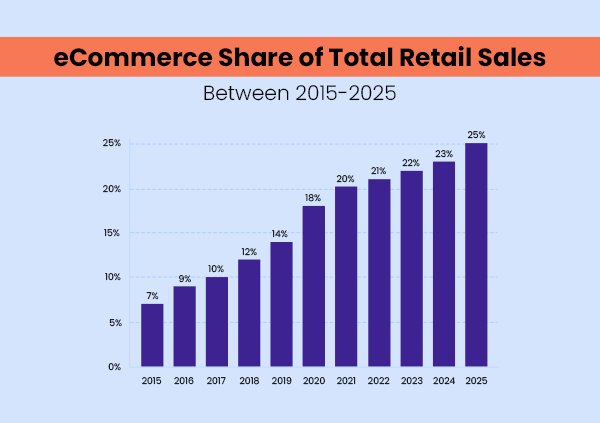
While eCommerce’s share of the retail market is rising, it’s important to note that traditional brick-and-mortar stores won’t disappear entirely. The future likely involves a balance between online and offline retail, with both channels coexisting to meet diverse consumer needs.
The evolution of augmented reality, artificial intelligence, and seamless omnichannel experiences will play pivotal roles in shaping this landscape. As eCommerce continues to innovate and adapt, its dominance is expected to strengthen. Still, a complete takeover is unlikely, fostering a retail space offering the best digital and physical stores.
What Approach Should You Follow For Your Business?
For a comprehensive and successful business strategy, consider adopting a hybrid approach combining eCommerce and physical stores and providing both advantages on a single platform.
This strategy leverages the strengths of both platforms, providing customers with a seamless and flexible shopping experience. Here are some hybrid options to consider:
1. Click & Collect and Curbside Pickup
Start a “Click-and-Collect Store,” where customers can order online and pick up their purchases in nearby stores. You can introduce curbside pickup options for extra convenience, catering to those who prefer a quick and contactless experience.
Walmart, The Home Depot, Best Buy, Lowe’s, Macy’s, and Nordstrom are some of the Top Companies in the USA that are exploring this new-age business model.
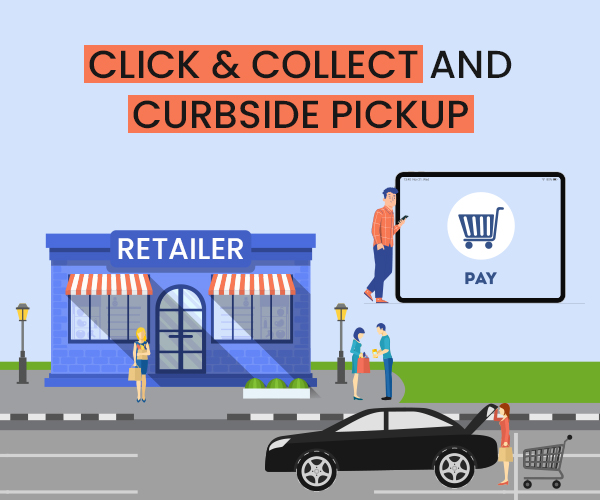
2. Pop-up Stores and Showrooming
Various brands are exploring the concept of pop-up stores to create a physical presence at strategic locations for a limited time. Showrooming allows customers to view products in person and then make purchases online, blending the benefits of both eCommerce and physical stores.
AiNSEL, Goop, Adore Me, Boohoo, and Brandless are a few names that use Pop-up showrooms to boost their eCommerce business and build community.
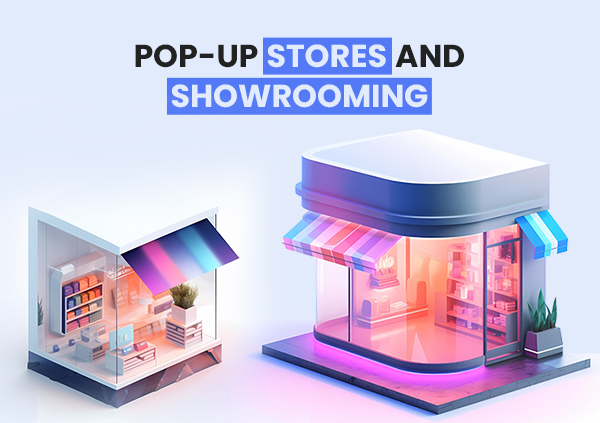
3. Combining Online and In-Store Experiences By Virtual Try-on
This hybrid platform creates a cohesive customer journey by integrating online and in-store experiences. Utilize technology to enhance in-store interactions, such as providing access to online reviews, personalized recommendations, and virtual try-on.
Lenskart, Farfetch, Warby Parker, L’Oreal, and Wacoal are some of the eCommerce platforms that offer virtual try-ons to test products virtually before purchase to increase your shopping experience.

4. Multi-channel Retailing
Embrace a multi-channel retailing strategy that integrates various sales channels seamlessly. This could involve selling products through your website, third-party online marketplaces, and physical stores. Ensure a consistent brand experience across all channels.
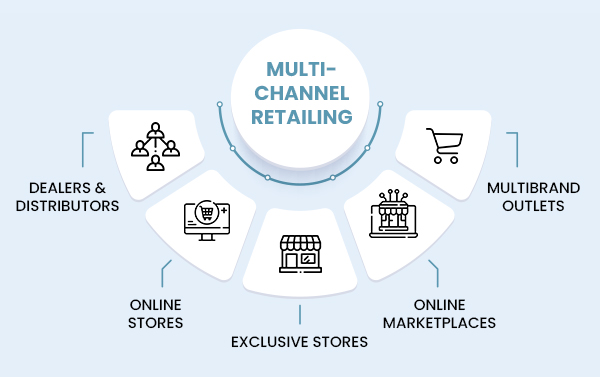
Adopting any hybrid option allows your business to cater to a wide range of customer preferences and behaviors, providing you with multiple sales channels. It enables you to offer the convenience of online shopping while still providing the tangible and immersive experiences that physical stores offer.
The key is to create a cohesive and integrated approach that enhances customer satisfaction and loyalty across all touchpoints.
Also Read: Types Of Business Models Startups Should Know
Outcome
The future of retail is not a competition between eCommerce and physical stores but a strategic fusion of both. Recognizing the strengths and weaknesses of each, businesses are navigating towards a hybrid model.
Click-and-collect, pop-up stores, and multi-channel retailing showcase a commitment to seamless, diverse shopping experiences. The evolving retail market emphasizes the importance of adapting to consumer preferences, creating a dynamic retail ecosystem that harmonizes digital convenience with the tangible allure of physical stores.
It’s not about domination; it’s about collaboration to meet the varied needs of the modern shopper.
FAQs
Yes, eCommerce is poised for a robust future. The continuous integration of technology, changing consumer behaviors, and global connectivity suggest a sustained growth trajectory. As technology evolves, so does the potential for eCommerce to innovate and offer more personalized, efficient, and convenient shopping experiences.
Despite the consequences of the pandemic in 2020, both the eCommerce and retail markets have been booming. eCommerce online sales scaled by 14.2% between 2020 and 2021, while total retail sales increased by 14%. So, regardless of your chosen option, the potential for success is enormous.
While eCommerce is experiencing significant growth, but it will never completely dominate physical stores. The future likely involves a coexistence of both channels. Factors such as diverse consumer preferences, the appeal of in-person shopping experiences, and the vast geographical and demographic variations in India contribute to the continued relevance of physical stores.
The future of eCommerce in India looks promising, driven by factors like increasing internet users, smartphone usage, high-speed internet, digital payment systems like UPI, and government initiatives such as Digital India.
However, challenges like logistics, loss-making eCommerce business, data security, and solutions for diverse consumer segments will define the eCommerce Industry’s growth trajectory.
The next trends in eCommerce will be the widespread adoption of augmented reality (AR), virtual reality (VR), virtual try-ons, and quick commerce. Additionally, integrating advanced artificial intelligence (AI) in online stores will allow for personalized recommendations that suit your physique and match your preferences.
Voice commerce and IoT integration will be additional features that will reshape the future of eCommerce.
